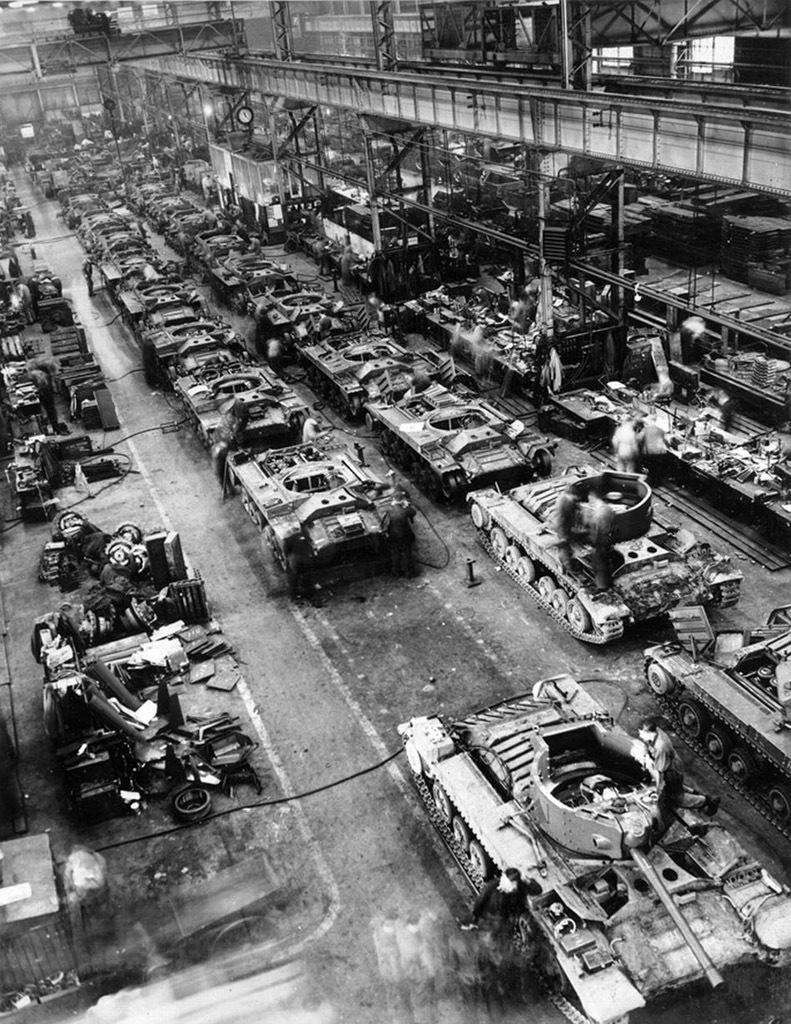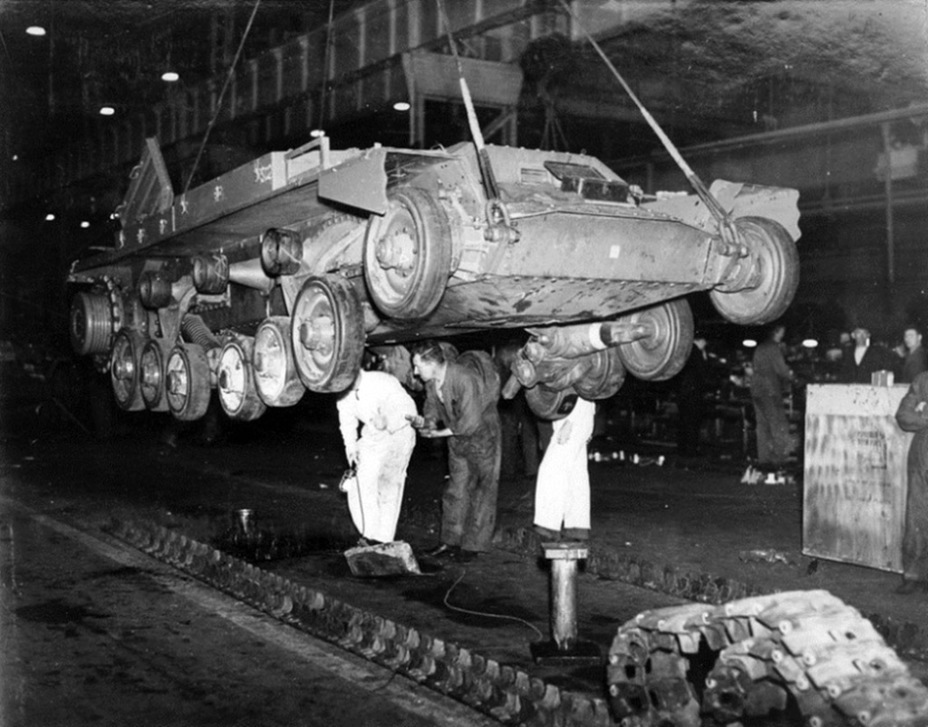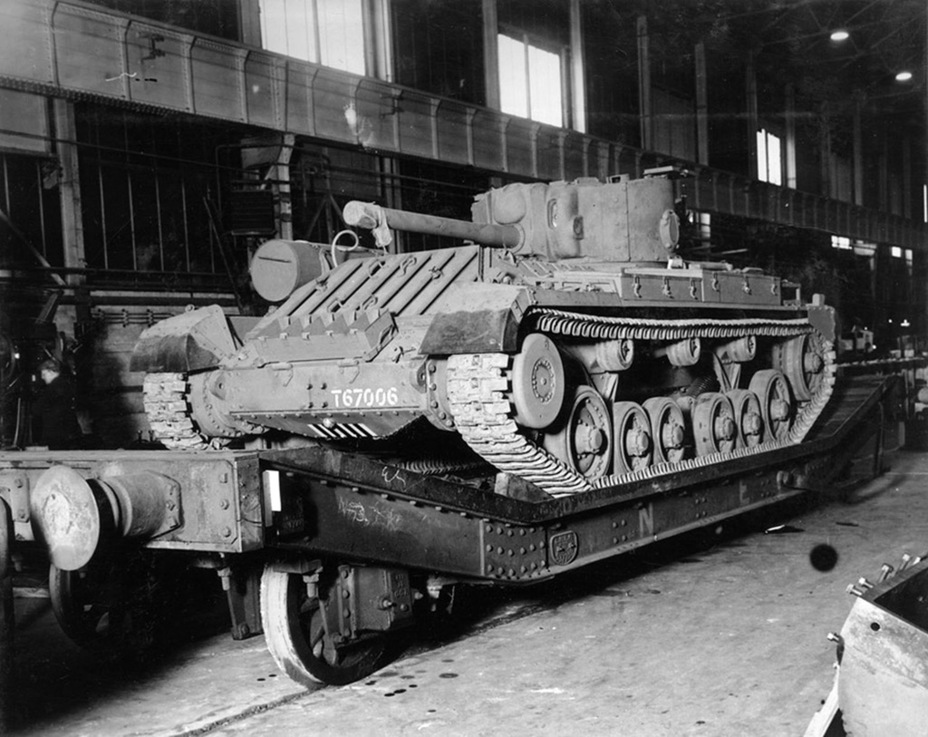At the moment of its debut in 1940, the Infantry Tank Mk.III, later known as Valentine, was the most balanced vehicle in the British army. Its low top speed was compensated by a rather respectable average speed, especially off-road. 60 mm of armour was very good for the time, and even in 1942 not every gun was capable of penetrating this much armour.
Of course, by 1942 the tank was becoming obsolete. While there was no hope of increasing mobility, there was a chance to improve the firepower. Heroic efforts by Vickers-Armstrongs engineers resulted in a significant increase in caliber, while the tank's mass remained unchanged. As a result, the Valentine fought until the end of the war. Individual vehicles even saw victory on German territory.
More gun, same mass
The 2-pounder gun was a fine weapon at the start of WWII. Its penetration characteristics were about the same as those of the German 3.7 cm Pak and the Soviet 45 mm anti-tank gun. However, one serious drawback of the British gun was the lack of an HE shell. British tank policy, born in early 1920s, dictated that tanks fight infantry either with machineguns or special howitzer tanks.
Nevertheless, the 2-pounder worked just fine as an anti-tank gun. However, this started to change in the spring of 1941, when PzIII and PzIV tanks with applique armour arrived on the battlefield. The applique armour did not make them invulnerable to Allied artillery, since several shots would knock them off and the front of the turret still had no additional protection, but this was just the beginning.
Production of the PzIII Ausf.J and PzIV Ausf.F began in the spring of 1941. The 2-pounder could penetrate their front armour only at point blank range. The British first faced these tanks towards the end of 1941, but the issue of reinforcing the tanks' armament was raised before that.
However, the British designers did not rest on their laurels in the meantime. As the Germans initiated work on the 50 mm tank gun in 1938, the British started working on a replacement for the 2-pounder gun in that same year. Work began on both tank and anti-tank versions of the 6-pounder (57 mm) gun. This caliber was a classic: famous «rhombus» tanks had this type of gun, and the Maxim-Nordenfelt guns used in German A7V tanks also had a caliber of 57 mm.
This was a progressive system for its time. It had a high muzzle velocity and penetration comparable to the Soviet ZIS-2, which had a longer barrel. The gun mount was also progressive, featuring a very low profile. However, work dragged on, and the first 50-caliber version didn't make it into production. The situation with 2-pounder gun production resulted in the more powerful gun getting held back. Production of the OQF 6-pounder Mk.II with a 43-caliber barrel only began in November of 1941.
The new tank gun was not only more powerful than the previous one, but larger. This was a fatal flaw for some tanks. For instance, the three-man turret of the Matilda tank did not fit such a large gun, according to British engineers. The design bureau of factory #92 didn't know about their conclusions when they managed to stick the 76 mm ZIS-3 into the same turret. The Crusader tank was suitable for the new gun, but the front of the turret had to be changed, resulting in the Crusader III tank. The Churchill needed a whole new turret. It was the Churchill III that first went into production with a 6-pounder gun.
Like the Matilda, the failure to fit a 6-pounder gun would have been a death sentence for the Valentine tank. A group of engineers headed by Leslie Little got to work on converting the turret a second time.
The Valentine III three-man turret was used as a basis of their designs. The larger gun did not allow a commander to fit, so it became a two-man turret wonce more. The front had to change was well, to move the trunnions forward. The engineers managed to achieve their goals, but at a cost: there was no room for a coaxial machinegun or a bomb thrower. The latter issue was partially resolved by installing two 4-inch No.2 smoke bomb launchers on the right side of the turret. The commander/loader and gunner received individual hatches for entering the turret.
The changes to the hull were minimal. Since the turret was heavier than before, the side armour had to be reduced to 50 mm. The mass of the tank was 17 tons: about the same as the Valentine III and VII.
A decision to put the tank with a 6-pounder gun into production was made in October of 1941. The tank did not yet exist in metal. It would be put into production without first building a prototype. The new tank was indexed Valentine VIII. The tank would be based on the Valentine II chassis with the AEC 190 engine. Contract TM6771 signed on October 7th included 435 Valentine VIII tanks, but was soon changed. Birmingham Railway Carriage and Wagon Company (BRC&W), which was supposed to build the Valentine VIII, built the Valentine III instead.
As a result, not a single Valentine VIII was built. Production of the Valentine IV with a GM 6004 diesel engine began in the fall of 1941. This engine was more powerful, and more importantly, more common. A decision was made to equip the more powerful tank with this engine.

The version with a GM 6004 engine was named Valentine IX. The tank had to wait: the Valentine V, which was also built without a prototype, had to go into production first. The Valentine IX chassis was somewhat modernized. The American engine was turbocharged with a more powerful injector, as a result of which its output increased to 165 hp at 1900 RPM. This small increase in power resulted in a notable increase in mobility, particularly off-road.

Changes were made to old contracts in connection with the new Valentine. Contract T2243, which had already changed once, was changed once more to 125 Valentine IV, 400 Valentine V, and 230 Valentine IX tanks. WD numbers used by Elswick Works for these tanks ranged from T.66591 to T.67220. This range included both Valentine V and Valentine IX tanks. The cost for one tank did not increase by much: the tank itself cost 5710 pounds Sterling, plus 4490 pounds for the engine and other components.
Contract TM6618 signed on October 7th, 1941, for 455 Valentine V tanks produced by Metropolitan Cammell Carriage and Wagon Company (MCCW) also changed. Now the factory was building 328 Valentine IX tanks with WD numbers T.82163–T.82617.
The first brand new contract, TM6116, was signed with Elswick Works on October 7th, 1941. It ordered 460 Valentine IX tanks with WD numbers T.122698-T.123157. Initially, the plan was to sign this contract to produce Valentine V tanks. A third contract was signed with Elswick Works on February 6th, 1942, TM11533. 475 more tanks with WD numbers T.123158-T.123632 would be built. Finally, the last contract numbered TM11532 was signed with MCCW in May of 1942. It ordered 460 tanks, but later this number was reduced to 260 tanks, numbered T.120690-T.121149.

Production of the Valentine IX began in the fall of 1942. The Valentine was the last tank that the British armed with 6-pounder guns. Only a few tanks received the 43-caliber Mk.II version, as soon after production of the 50-caliber Mk.V with superior penetration began. Elswick Works completed contract TM6618 in January of 1943.
The return of the coaxial machinegun
The Valentine IX was harshly criticised by tankers after its first battles, particularly regarding the armament. A lack of coaxial machinegun turned the Valentine IX into a tank destroyer. There were no HE shells available, and fighting enemy infantry with AP shot was not the brightest idea. The tankers demanded that the coaxial machinegun be returned.
The turret had to be changed again to meet this requirement. An extra bulge was added to the right of the gun, which housed a BESA machinegun. The tank could once again fight infantry, but the addition of a machinegun weakened the turret, since the mantlet was only 14 mm thick. The machinegun mount was vulnerable even to heavy machinegun fire.
Some changes were made to the chassis as well. In addition to 4 inch smoke bomb throwers, two containers for smoke bombs were added to the rear. The same containers were added to other British tanks, including the Cromwell and Comet. The headlights were also changed. These changes were not drastic, but they make it easy to distinguish the Valentine X from its predecessor.
New contracts for the Valentine X were not signed, old ones were simply altered. For instance, the number of Valentine IX tanks built according to contract TM11352 decreased to 30. However, the number of Valentine X tanks built here was not high, only 35 units. The contract with Elswick Works was altered as well. Now contract TM11533 included 275 Valentine IX and 100 Valentine X. 135 Valentine X tanks were built in total.
Experience in North Africa and a comparison with British tanks demonstrated the weakness of the policy to only equip tanks with AP shot. However, British generals maintained that 57 mm HE shells would not be effective. A consequence of this was the introduction of the OQF 75 mm. This tank gun was similar to the American M3, used in Lee, Grant, and Sherman tanks. The ammunition it used was the same. The gun fit into the same turrets that previously housed the OQF 6-pounder, so the idea to install it in the Valentine was obvious.
The new version of the Valentine was indexed Valentine XI. Since the new gun fit into the old turret, it was not changed. Only the front of the tank was different. The British finally remembered that you could built a tank with something other than rivets and bolts. At the very least, the front part of the hulls built at Elswick Works was welded. Judging by photographs, tanks built at MCCW were still assembled using rivets.
Production of the Valentine XI was also done through old contracts. Elswick Works built 100 tanks of this type. The last tank was delivered on September 29th, 1943. MCCW had a smaller output: 16 tanks in its first contract and 20 in the second, a total of 36. Another 175 Valentine XI tanks were built in a different way.
Like the Valentine V, 6-pounder and 75 mm gun armed Valentines were built in a special variant. Its history began in 1941, when the Hungarian engineer Nicolas Straussler proposed a system that made any tank amphibious. Similar work was performed in Germany, namely the Schwimm-Pz.Kpfw.II. The Germans also had Tauchpanzer III and IV tanks, which drove on the sea floor. The German designs were complicated and expensive. In addition, their equipment had to be carried separately.
The Duplex Drive (DD) system was different. First of all, it was suitable for light and medium tanks. Second, the Duplex Drive could be set up in 20 minutes and deflated even faster than that. This allowed tanks to land and immediately enter battle. The Duplex Drive did not need to be removed after use. Straussler's proposal was also much cheaper, which made it viable.
Successful trials of a Tetrarch DD tank paved the way for the Valentine, the most numerous British tank of the time, to be converted in the same way. After trials of a Valentine II DD in June of 1942, the British ordered 450 DD sets to equip tanks with GM 4006 engines. The priority was given to Valentine IX tanks, but mass production had not yet begun. The contract signed on July 6th included 214 Valentine V and 236 Valentine IX tanks. The production of Valentine DD tanks was delayed, but the number of Valentine tanks with 6-pounder guns crew. By the end of 1942, a decision was made to build 135 Valentine V DD and 315 Valentine IX DD tanks.
In practice, 160 Valentine V DD and 312 Valentine IX DD were built, all at MCCW. 175 Valentine XI DD tanks were also built at MCCW.
In total, 1753 Valentine tanks with long guns were built.
Worse than the Sherman
Various production and technical difficulties led to constant delays of Valentine IX production. When it did start, production was plagued with technical issues. This is often skipped over by British sources, but correspondence that remains in the Central Archive of the Ministry of Defense of the Russian Federation reveals that a large number of problems were experienced with the new gun at first. The unreliable elevation mechanism was the number one flaw. Judging by a list of changes made in production, this flaw affected all tanks with 6-pounder guns. These difficulties were overcome around early 1943.
The debut of the Valentine IX only took place in early 1943. The war in North Africa had passed a turning point by then. The Italian-German forces lost the Battle of El Alamein and began their retreat to the west. Their rapid retreat brought them to Tunisia. Here is where the Valentine IX made its debut. The offensive in Tunisia coincided with a mass delivery of Sherman II and Sherman III tanks (Medium Tanks M4A1 and M4A2). They were first used in the Battle for El Alamein, with stunning results. British tankers received a tank of their dreams, compared to which the products of British tank industry paled. Only the Churchill III and IV looked comparable.
The fighting in Tunisia sealed the Valentine's fate. After the surrender of Italian-German forces in North Africa the Valentine was pulled from the front line. Newly produced tanks were sent to the USSR. Out of 1011 Valentine IX tanks, 836 were sent to the Eastern Front, more than 80%. More than half of Valentine X tanks were sent there as well. By the end of December 1943, only 71 Valentine IX/X and 220 Valentine IX DD remained in Britain. 88 Valentine IX tanks remained in Iraq, where they were used by Polish units.
The Valentine IX DD was obsolete, but still offered some value as an amphibious tank. As a result, over 100 tanks of this type were transferred to Italy by June 1944. As of April 7th, 1945, the 15th Army contained 128 Valentine IX tanks of all types, however only 4 were on the front line. At the very least, they saw some action.
The fate of the Valentine XI was much more interesting. Unlike earlier versions, they were never sent to the USSR. These tanks, as well as Valentine X, were used as command tanks in units equipped with the Archer tank destroyer. The British followed the same logic as the Soviets who used T-70B tanks in SU-76M units. The chassis was the same on both vehicles, and the Valentine was fine for a command tank. Command tanks in the British army often had their cannons replaced with dummies, but the Valentines kept their guns. Each tank carried only 39 rounds of ammunition.
The Valentine X and XI lasted for a long time in the role of command tanks. As of June 1945, the 21st Army included 16 Valentine X and 14 Valentine XI tanks. They were used by units attached to the 3rd, 5th, 51st, and 2nd Canadian Infantry Divisions. These tanks drove all the way to Germany. Footage exists of a Valentine XI tank next to the chassis of the German super-heavy E-100 tank. The Valentine was the longest living design of all British wartime tanks.
4 Valentine tanks with long guns survive to this day, all of them Valentine IX. One tank that fought for the Red Army is being restored in Poland. Another one waits its turn in Bastogne. There are two Valentine IX tanks in Britain, both of them mobile. One is a part of the Bovington Tank Museum collection. The other is the only Valentine IX DD that survives to this day. When John Pearson found this tank, it was being used by a farm as a bulldozer without a turret. Restoration took more than 20 years, but the result was a fully complete tank, which takes place in many military historical events.
Translated by Peter Samsonov. Read more interesting tank articles on his blog Tank Archives.
Sources:
- British Infantry Tank Mk III Valentine, Part 2, Dick Taylor, Progress Publishing, 2010, ISBN 978–83–60672–15–0;
- Into the Vally: The Valentine Tank and Derivatives 1938–1960, Dick Taylor, MMP Books, 2012, ISBN 978–83–61421–36–8;
- National Archives and Records Administration;
- Author's photo archive;
- http://www.chroniclelive.co.uk.






